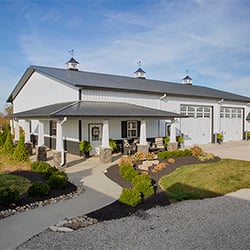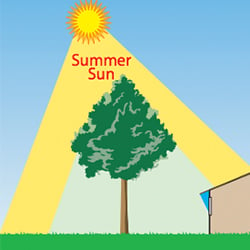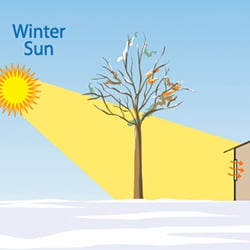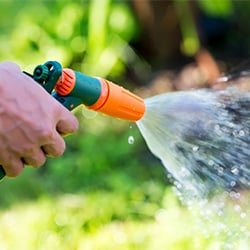Posts | Building Tips | Energy Efficiency
3 Energy-Efficient Landscaping Tips for Your Pole Barn
Cori grew up on her family's small grain and livestock operation in Northwest Indiana. In 2018, she graduated Summa Cum Laude with a Bachelor's degree in Business Administration & Marketing from Marian University Indianapolis. Having shown beef cattle for 12 years at the county, state, and national levels, Cori chose to pursue a career in agriculture. Today, she serves as the Marketing Content Creator on the FBi team. In her free time, Cori enjoys spending time with family and friends, watching sports, listening to live music, and traveling.
Spring has sprung! The remaining evidence of last winter’s snowfall is melting away. Seeds are starting to take root.
The surrounding scenery is coming to life with new sprouts and blossoms. Warmer temperatures are here to stay. Post frame projects are in full swing.
It’s our favorite time of the year. Is it your favorite time of the year too?
Recently, your post frame builder completed a custom 56' x 80' x 14' hobby shop equipped with a deluxe kitchen for social gatherings and storage room for fishing equipment.
While the interior of your building is coming along nicely, the exterior needs a little sprucing up. As you enjoy the new season, there’s no better time to start planning the landscape design around your pole barn.
Not only will ornamental features add curb appeal (increasing your property value), but it’ll also reduce heating and cooling costs.
According to the U.S. Department of Energy, landscaping for energy efficiency provides, on average, enough savings to return an initial investment in less than eight years. That’s impressive!
If you already have a landscape design, you don’t have to rule out energy efficiency entirely. You can still add a couple of trees and shrubs here and there. It’s never too late to start saving money.
Are you ready to slip on the gardening gloves? Maybe you’re not afraid to get your hands dirty. In this article, we provide helpful landscaping tips based on your climate and potential areas of energy efficiency.
What is Your Regional Climate?
For an effective, energy-conserving landscape design, you’ll need to consider the climate of the area in which you live.
The U.S. can be divided into four regional climates:
- Temperate
- Hot-arid
- Hot-humid
- Cool
Each climatic region has its own strategy to help you improve your energy efficiency. Below, we breakdown the four regional climates.
Temperate areas take advantage of the sun’s warming effect in the winter. Then, it deflects cold wind with windbreaks on the north and northwest sides of a post frame building. During the summer, the structure will need shade protection from the glaring sun.
States: Arkansas, Connecticut, Delaware, Kentucky, Maryland, New Jersey, North Carolina, Oklahoma, South Carolina, Tennessee, and Virginia.
Hot-arid and hot-humid regions rely on the shade to cool the walls, windows, and roof of a pole barn. Summer winds work to cool the structure naturally. Similar to temperate, hot-humid climates use the sun to warm a post frame building in the winter.
States: Alabama, Arizona, California, Florida, Georgia, Hawaii, Louisiana, Mississippi, New Mexico, and Texas.
Cool areas require dense windbreaks to protect structures from brisk winter winds. If the summer heat is an issue, provide shade on the south- and west-facing sides of your pole barn.
States: Alaska, Colorado, Idaho, Illinois, Indiana, Iowa, Kansas, Maine, Massachusetts, Michigan, Minnesota, Missouri, Montana, Nebraska, Nevada, New Hampshire, New York, North Dakota, Ohio, Oregon, Pennsylvania, Rhode Island, South Dakota, Utah, Vermont, Washington, West Virginia, Wisconsin, and Wyoming.
On top of that, you’ll need to factor the microclimate into your landscaping strategy. A microclimate is an immediate climate surrounding a house or building.
Your pole barn may receive more rain, shade, snow, sun, or wind than the average conditions for your area. Therefore, understanding your climatic region and microclimate will help determine which plants may or may not flourish in your landscape.
3 Landscaping Tips for Your Pole Barn (To Help Improve Energy Efficiency)
Next, you’ll need to decide the reasoning behind your landscaping. Is it to provide shade for your post frame structure? To shelter it from the wind? Settling on a plan of action will determine which plants to use in your landscape design. Incorporate these three tips into your landscaping strategy.
1) Landscaping for Shade
Shading is the most cost-effective way to reduce your pole barn’s energy costs. To achieve a shady landscape, you must incorporate deciduous trees.
A deciduous (pronounced dih-sij-oo-uhs) tree is a giant flowering plant. Popular examples include:
- Ash (be cautious of emerald ash borers)
- Elm
- Maple (imagine the colorful foliage during autumn)
- Oak
We recommend planting deciduous trees with high spreading crowns (i.e., leaves and branches) to the south of your post frame building.
Why? Because they block the high summer sun and allow the low winter sun, reducing cooling and heating costs, respectively.
To the west, we recommend planting trees with lower crowns (e.g., evergreens). They’ll provide continuous shade from the lower afternoon sun angles.
If you live in a colder climate, do not plant deciduous trees on the southern side of your pole barn. The branches will block some winter sun. Solar energy is crucial in minimizing your heating bill.
Avoid planting trees close to your structure. When the plant matures, you don’t want their roots to damage the concrete foundation. Furthermore, their branches can cause damage to your roof.
Trust us, you don’t want to spend your extra cash from energy savings on preventable building repairs.
2) Landscaping for Windbreaks
Do you live in the Midwest? If so, then you’re all too familiar with Mother Nature’s roaring wind. During winter months, the brutal gusts of chill probably affect the temperature of your post frame structure.
To lessen the energy bill, you must incorporate windbreaks into your landscaping strategy. A windbreak will decrease heating costs by lowering the wind chill surrounding your pole barn. The following trees provide excellent wind protection:
- Camphor
- Cypress
- Evergreen
- Oak
- Pine
We recommend keeping the distance between your building and windbreak at 2x to 5x the tree’s mature height. Again, you don’t want the tree(s) to block heat from the winter sun.
Bushes, shrubs, and vines work to block the wind at ground level. They should be planted on the windward side to keep snow from blowing up against your structure.
Avoid planting dense greenery next to your pole barn. This up-close placement can trap the humidity and cause condensation issues.
For an extra layer of protection, you should consider adding a tall fence, retaining wall, or additional windbreak rows.
3) Water Conservation
Of course, all these trees and shrubs you just planted will require care and maintenance. The last step is to conserve your water source.
The following practices will help you cut back on water use:
- Always group plants that require the same amount of hydration
- Aerate your soil to improve water flow (reduce runoff)
- Use mulch to keep plant roots cool (control weed growth)
- Raise the lawnmower blades for taller grass (creates shade and retains water)
According to gardening professionals, you should water your plants in the morning when evaporation levels are significantly lower. The rate of evaporation is higher at mid-day.
Don’t forget to keep your plants healthy by fertilizing, pruning, and weeding regularly. Please keep an eye open for annoying pests that could cause damage.
Do you live in a hot-arid or hot-humid region? If so, you’ll want to research the benefits of xeriscaping, which means “dry landscape.” It’s not to be confused with zeroscaping (e.g., rock gardening).
This landscaping technique utilizes native plants and hardscaping materials, which is convenient for water-restricted zones. Not to mention, there’s less mowing and weeding involved.
Overall, these practices will help your landscaping flourish without hurting the water supply.
Do You Need Help Selecting the “Right Plants?”
As mentioned above, you must select plants based on your climate zone and microclimate. Otherwise, your landscaping strategy will fail miserably, and that’s throwing money down the drain.
If you don’t have a green thumb, then how are you supposed to know which plants to choose? After all, trees and shrubs are available in a variety of sizes, densities, and shapes. It’s enough to make your head spin.
But have no fear. You can reach out to your county extension office, local nursery, or a professional landscaper for assistance. They’ll answer questions and make sure your landscape design is set up for success.
Which Type of Pole Barn Landscaping Will You Choose?
Whether your goal is to save money or impact the environment positively, an energy-efficient pole barn is a smart move. Remember, it takes time to reap the full benefits of energy efficiency, but at least you’re taking a step in the right direction. Patience is a virtue.
For more helpful tips, you can download our FREE “Post Frame Energy Efficiency Guide.” You’ll become more knowledgeable and confident in the building process and discover more energy-saving methods. As a result, you’ll have a quality structure that provides the desired balance between initial investment and long-term efficiency.
Have more questions about pole barn energy efficiency not covered in this article? Please contact FBi Buildings at 1.800.552.2981 or click here to email us. If you’re ready to get a price, click here to request a quote and a member of our sales team will call you.



